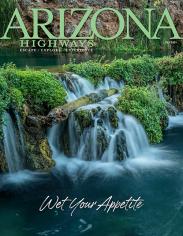Pull into the Fort Valley Experimental Forest, near Flagstaff, and you might think you’ve arrived at a sleepaway camp, not a historic facility for forestry research. A rustic compound of wood-frame buildings, some dating to the early 1900s and painted white with green window and door trim, is arranged in a stand of ponderosa pines, firs and spruce.
Now listed on the National Register of Historic Places, Fort Valley was established in 1908 as the country’s first forest research experiment station, with a mission to study ponderosa pine regeneration as Northern Arizona’s forests struggled to recover from clear-cutting. Early climate studies took place here, too. And more than a century after its founding, Fort Valley still plays a vital role in researching forest regeneration and thinning.
A fire crew mops up a meadow smoldering after a controlled burn as W. Keith Moser (pictured), a research forester and the scientist in charge at Fort Valley since 2013, greets us. He clearly takes pride in the site, both as a forestry landmark and for its ongoing work.
“I was in national forest inventory for 10 years — that means I didn’t collect data, I analyzed data,” he says. “I dealt, if you will, with ‘computer trees’ for 10 years. This was a chance to work with actual trees and stand manipulation on the forest. And in a previous life, many years ago in college, I was a history major. So, the idea of being tied into this kind of history was really appealing.”
Encompassing four areas totaling 5,270 acres on the Coconino National Forest, Fort Valley includes uncut old-growth ponderosa stands that survived because the site was too far from the railroad for profitable logging. Moser also points out “black bark” trees — pines that grew after the confluence of a rare wet spring and an unusually heavy seed crop in 1919. “They still speak about that spring with reverence,” he says. “People thought they had solved the regeneration problem. But we’ve never been able to re-create those conditions in the 100 years since.”
Encouraged by researcher Raphael Zon, U.S. Forest Service Chief Gifford Pinchot proposed a network of forest stations around the country in the early 1900s. Alarmed by the decline of the area’s ponderosa stands, Flagstaff lumbermen Timothy and Michael Riordan supported the establishment of a station there.
In Fort Valley’s creation story — as recounted by the station’s first director, Gustaf A. Pearson — “it was a sultry afternoon in August 1908” when Zon arrived in Flagstaff to help scout the site. Zon, Pearson and forester Willard Drake set out on what Pearson described as “our phlegmatic livery stable cayuses” — a fancy, if archaic, way to say the men rode slow horses.
When a classic Flagstaff monsoon storm broke the summer heat, the foresters sheltered in a barn before resuming their ride to Fort Valley. Once there, they liked what they saw. “Here we shall plant the tree of research,” Zon grandly declared. Pearson would soon settle into an uninsulated two-room cabin as the station’s one-person staff, with only a pair of mules named Pat and Mike serving as his support crew. And despite the early hardships, he remained director at Fort Valley until his 1944 retirement.
Moser leads us through several buildings, chilly even on a sunny November afternoon. The 1934 headquarters was constructed around what’s described in Fort Valley’s NRHP application as “a floor-to-ceiling walk-in vault” that wouldn’t have otherwise fit through a door — a necessity because the site’s staffers originally were paid in cash.
Later, Moser shows off an intricate, hand-drawn diagram of one area that identifies not only individual trees but even stumps, along with a July 1933 map that precisely tracks a mistletoe infestation in another Fort Valley plot. But for all the maps’ precision, Moser says, the station’s archives gradually devolved into unorganized stacks. Flagstaff author and historian Susan Deaver Olberding, who’s written definitive accounts of Fort
Valley, brought order to the chaos, Moser says.
While Moser is here for the trees — real trees — he marvels at the invaluable data gathered at Fort Valley. He describes climate studies conducted on the San Francisco Peaks, where five weather stations were established at different elevations in 1916. Now, he hopes to re-establish those sites by deploying a network of automatic weather stations.
“Here’s one of the new stations, but in pieces,” he says. “These are automatic, real-time, and can provide everybody with information that you can upload to the web. I just have to figure out how to assemble them. I never was very good on Christmas Eve, trying to put my kids’ toys together.”
In a time when everyone talks about artificial intelligence, Fort Valley is a monument to the intelligence gathered by people, sometimes under the harshest of conditions. “That’s one of the neat things about old experimental forests,” Moser says. “Those kinds of data are priceless. You just can’t re-create that. Even if future conditions are not going to be the same as they were back in the day, you need these long-term views to see what the trends are. There are people continuing measurements here that started in 1909. Where else are you going to get 100 years of data? When you have those data, it’s just precious. That’s what’s really exciting about Fort Valley.”
NEAR FLAGSTAFF Fort Valley Experimental Forest, fs.usda.gov/research/rmrs/forestsandranges/locations/fvef

